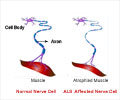Causes / Risk Factors of Amyotrophic Lateral Sclerosis (ALS)
Researchers are still probing the exact cause of ALS, although a plethora of factors, such as listed below, have been associated with the disease:
- Familial ALS (or FALS) – In case of 20% of FALS an inherited autosomal dominant mutation on chromosome 21 is implicated. The children of these FALS patients have a higher risk factor for developing the disease.It must be noted that close family members carry risks similar to that of the general population.
- Dietary factors - such as a neurotoxin present in the seed of the tropical cycad plant, cycus circinalis, is believed to have been the reason for increased incidence of ALS in West Pacific Guam.
- Mutation in the gene SOD1 (super oxidase dismutase 1) is another cause that is often cited. The gene SOD1 produces the enzyme superoxide dismutase which acts as an anti -oxidant and protects the body from the free radical super oxide. The accumulation of free radicals is among the primary cause formany of the neurological diseases including ALS. It is now believed that a gain in function (due to SOD1 mutation) and not a loss, is the cause of ALS.
- Glutamate, a neurotransmitter, is said to be present in higher quantities in the spinal fluid and serum of patients with ALS. Glutamate in higher quantities is said to be neuro-toxic.
- Autoimmune impairment is another cause of ALS which is believed to be brought about when the body’s immune system gets impaired and starts attacking normal cells causing motor neuron degeneration. Recent studies indicate that the microglia (nervous system’s immune cells) are intensely involved in the late stages of the disease.
Risk factors Amyotrophic Lateral Sclerosis (ALS)
- Exposure to neurotoxins, heavy metals or viruses are also believed to be trigger factors.
- Spinal cord -involving surgeries could also play a role in damaging nerve fibres and causing ALS.
- Military service -It has also been reported that those in the military have a 60% increased chance of getting the disease when compared to ordinary folks.
- There is a possible link between the disease and exposure to pesticides as evidenced by the increased incidence among soccer players.
- Age - People who are between the ages of 40-60 are at a higher risk.
- Sex- Males are more affected than females.
- Geographical factors-Japan, West Guinea and Guam reported a higher incidence of the disease.










